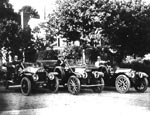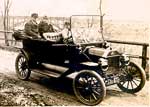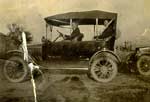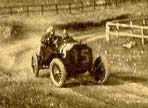 Another
surprise for me was the maximum speed the cars reached on bumpy, windy, narrow roads.
There were places that the top speed recorded was 75 mph and the average winning pace was
46 mph!
Another
surprise for me was the maximum speed the cars reached on bumpy, windy, narrow roads.
There were places that the top speed recorded was 75 mph and the average winning pace was
46 mph!
The race was intended to cover 300 miles, but after only 240 miles and just under seven
hours, the race was cancelled. Only four cars were not running at the conclusion of the
race. According to the New York Times, which covered the race extensively:
"The race was called off twenty minutes after noon, when the immense crowd that
lined the course had crowded on the track too densely for safety. The crowding on the road
was due to the beginning of the crowd's move to leave the course and the natural
restlessness following the decision as to the leading positions."
| The route, covering 30 miles, began in
Briarcliff Manor where the official Grandstand was situated. From there, the cars traveled
north on (now) route 100 to Kitchawan, a hamlet of Yorktown located south of the Croton
Reservoir, passing Echo Lake and Merritt Corners. At Pines Bridge they followed Croton
Lake Road east to Pines Bridge Road, then southeast to (old) Croton Lake Road, south to
(old) Kisco Avenue to Main Street in Mt. Kisco. There, a speed check was placed and all
the cars had to take a full 10 minutes going through the village. Next they followed (old)
Route 22 south to the Kensico Dam, across the dam, then north on West Lake Drive to
Lakeview Avenue (old Tarrytown Road). They proceeded north on Route 9A/100 to Route 100
back to Briarcliff for one complete lap. This was supposed to be repeated ten times, for a
total distance of 300 miles. |
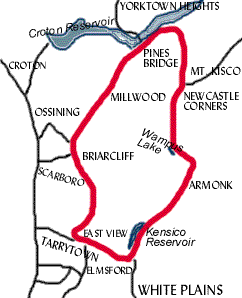 |
 All along the route, parking
spaces were sold for spectators' automobiles. They settled themselves on hillsides
overlooking the course, arriving there the evening before. They built campfires in the
open, around which they cooked meals and shared fellowship as they awaited the anticipated
4:45 AM start of the race. The Times reported the following:
All along the route, parking
spaces were sold for spectators' automobiles. They settled themselves on hillsides
overlooking the course, arriving there the evening before. They built campfires in the
open, around which they cooked meals and shared fellowship as they awaited the anticipated
4:45 AM start of the race. The Times reported the following:
"Picturesque Night Scene. The lines of cars made a most picturesque spectacle,
with glaring headlights staring out into the misty night, each housing a party of autoists
so keen to see the race that they were ready to stand any discomfort to gratify their
desire. Interspersed with these headlights were numerous campfires blazing in fields and
meadows, while seated around them Indian fashion, groups sang and frolicked as though care
was unknown to them. A stranger dropped unprepared in the midst of the scene would have
thought the spectacle a gathering of gypsy clans from all over the world, regaling the
night, after their state conclave, with jest and song."
Those who didn't drive to the race came by train, trolley, foot and horse. Extra trains
were added for the occasion by The New York Central Railroad on all three of its
divisions. Those who came by railroad, however, were not satisfied by the service. The
first train to leave Grand Central Station took three hours to make the usual one-hour
run, thus delaying all following trains. The first group of spectators arrived just before
the appointed start of the race, causing havoc in the street near the Grand Stand and
delaying the start until after 5:00 AM.
"A hurry call was sent out for marshals, and 200 of the citizen soldiery, armed
with canes and official insignia, answered the call. The clearing of the crowd was begun
in no light-handed manner, and several brawls ensued." reported the Times.
At least 1,000 National Guardsmen at ten makeshift headquarters were used to patrol the
course and several hundred paid policemen were hired to insure there were no fatalities,
such as occurred at the Vanderbilt Race. The State Engineer, Frederick Skene, required a
$6,000 deposit which could be used for repair of the roads following the race, and the
Village of Greenburgh demanded a $100,000 deposit against accident in the village. Skene's
demand was met, but the race organizers had already secured insurance from Lloyds, which
satisfied the Village officials.
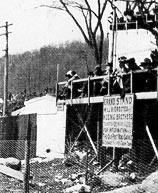 On the Sunday preceding the
race, a dozen of the racers were out practicing on the course. The large number of
visitors who came to watch cut up the muddy roads and left them in terrible shape. These
were repaired immediately after the practice and work continued on the roads all week.
There were two accidents involving racecars during that week: James B. Ryall and Edward
Murray in their Matheson and Arthur Campbell and his "machanician" Ralph De
Palma in their Allen-Kingston. Campbell managed to make the race after the car was
repaired.
On the Sunday preceding the
race, a dozen of the racers were out practicing on the course. The large number of
visitors who came to watch cut up the muddy roads and left them in terrible shape. These
were repaired immediately after the practice and work continued on the roads all week.
There were two accidents involving racecars during that week: James B. Ryall and Edward
Murray in their Matheson and Arthur Campbell and his "machanician" Ralph De
Palma in their Allen-Kingston. Campbell managed to make the race after the car was
repaired.
AND THE WINNER IS...Louis (or Lewis) Strang, driving a 50 hp Isotta-Frascini car, owned
by J.H.Tyson. Tyson spent $25,000 to win the trophy, and Strang received $1,000 plus a
bonus of $3,000 from Tyson. Louis Strang was born in Amsterdam, NY and probably not
directly related to the large Strang clan of Yorktown. According to the Times:
"Strang spent five weeks at Briarcliff preparing for the race. He used Mr. Tyson's
six-cylinder Ford in the preliminary practice, most of which was put in the early morning
hours, while the other drivers were sleeping. The Isotta, which Strang drove in the race,
was taken over the course only twice before the contest. After the tuning-up spin it was
locked in Mr. Tyson's garage at White Plains, and an employee stood guard over it night
and day."
In second place was Emanuel Cedrino, driving a 60 hp Fiat, owned by the Fiat Company,
and third place was won by Guy Vaughan driving a 30-60 hp Stearns car, owned by Wyckoff, Church
& Partridge. Strang, who started fourth, assumed lead half way into the first circuit
and remained there throughout the race. Obviously, knowledge of the course made the
difference. Cedrino was the favorite to win.
 The first
accident in the race occurred in a Simplex driven by Watson, who hit a post near East View
and he and his "machanician" were thrown out of the car. They were able to
continue the race, but four others involved in accidents weren't so lucky: the Maja driven
by Murphy had a wheel collapse under it near Valhalla, smashing the car; a cylinder
cracked in the Fiat driven by Parker; Mulford, while cranking his Lozier, let the crank
slip and it flew around and struck him on the foot, breaking his toe; and the
Allen-Kingston driven by Campbell, which had "turned turtle" during practice,
broke an axle and went into a ditch.
The first
accident in the race occurred in a Simplex driven by Watson, who hit a post near East View
and he and his "machanician" were thrown out of the car. They were able to
continue the race, but four others involved in accidents weren't so lucky: the Maja driven
by Murphy had a wheel collapse under it near Valhalla, smashing the car; a cylinder
cracked in the Fiat driven by Parker; Mulford, while cranking his Lozier, let the crank
slip and it flew around and struck him on the foot, breaking his toe; and the
Allen-Kingston driven by Campbell, which had "turned turtle" during practice,
broke an axle and went into a ditch.
Extensive and immediate coverage of the race by the New York Times newspaper was
made possible by the use of the Marconi Wireless Telegraph, which sent constant updates
and bulletins to the tower of The Times Building in New York City. The bulletins were sent
courtesy of The Lozier Company, which had a wireless station in its headquarters at
Briarcliff Manor, as well as Pines Bridge, Mt. Kisco, Newcastle, Valhalla and East View.
These stations were connected to other locations by telephone. Employees of the Lozier
Company and officials of the course gathered the news and took it to the nearest station.
The Times reported: "All night long wireless telegraph experts had been
busy arranging the apparatus and getting in tune with the Lozier station at Briarcliff
Manor, with wireless and telephone connections to various other points on the
course."
The system worked well, with the exception of an occasional signal from other areas,
from as far south as Cape Henry, Virginia. However, once the program included music. The
Brooklyn Navy Yard school of electricity had been conducting experiments in "wireless
telephony" and when the Times' machine got in tune with the navy yard's
apparatus, band tunes playing on a phonograph could be heard!
The worst injury reported was that of an eight-year-old boy who was hit by an
"autoist" returning from the race. The man blew his "siren" at a group
of children playing in the street, but one child failed to move and was hit. The Times
reported that "30 people were arrested in the Bronx on their way to the race by
bicycle and motorcycle police, including one speeder at "pistol's point". Many
were well-known people of the time.
Written by Linda L. Kiederer
Photos courtesy of Town Clerk's Office, The Westchester County Historical Society and the
North Castle Historical Society.
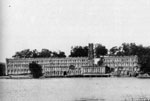 That fact was certainly true in northern Westchester. Cars were
being manufactured, however, as close by as North Tarrytown at the Walker Locomobile
plant, which opened in 1900. This later became a Maxwell-Briscoe plant, which furnished
numerous Maxwell automobiles for prosperous Yorktown residents such as the Kear, Conklin,
Lee and Forman families.
That fact was certainly true in northern Westchester. Cars were
being manufactured, however, as close by as North Tarrytown at the Walker Locomobile
plant, which opened in 1900. This later became a Maxwell-Briscoe plant, which furnished
numerous Maxwell automobiles for prosperous Yorktown residents such as the Kear, Conklin,
Lee and Forman families.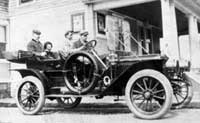 This April 24th will be the 91st anniversary
of the "First American International Road Race", held in northern Westchester,
an event not unlike our modern day commuter race which occurs every weekday from Yorktown
and neighboring communities (reminiscent of the running of the bulls!). April 24th this
year falls on a Saturday, and the throng of cars will be travelling to local building and
garden centers as the crunch of motorists shop to spruce up their homes for spring!
However in 1908, this particular road race was the first of its kind and thousands came to
watch.
This April 24th will be the 91st anniversary
of the "First American International Road Race", held in northern Westchester,
an event not unlike our modern day commuter race which occurs every weekday from Yorktown
and neighboring communities (reminiscent of the running of the bulls!). April 24th this
year falls on a Saturday, and the throng of cars will be travelling to local building and
garden centers as the crunch of motorists shop to spruce up their homes for spring!
However in 1908, this particular road race was the first of its kind and thousands came to
watch.


